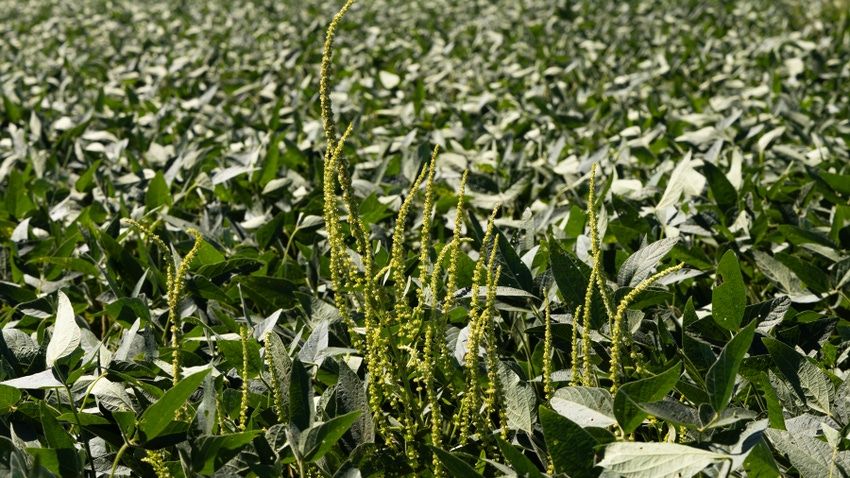March 5, 2024

Recent reports of dicamba-resistant waterhemp in Iowa fields were not unexpected. Weed scientists know that resistance in waterhemp populations happens faster than new herbicides are discovered.
While the registration of 2,4-D and dicamba products for over-the-top use in herbicide-resistant soybean varieties has improved waterhemp control for many farmers, weed scientists warned that these herbicides would eventually select for resistant waterhemp populations.
Bayer reported the discovery of two dicamba-resistant waterhemp populations in Iowa — Scott County in 2021 and Marshall County in 2022. Corteva has also reported the discovery of a suspected 2,4-D-resistant waterhemp population in Iowa.
“These reports emphasize the need to use herbicides wisely and diversify weed management tactics beyond herbicides, especially as more farmers rely on herbicide Group 4-based postemergence weed control in both corn and soybean crops,” says Meaghan Anderson, an Iowa State University Extension field agronomist.
“These cases serve as warnings of where we are headed in many fields with our heavy reliance on growth regulators postemergence, in some cases, in both corn and soybean,” she adds. “As we potentially see reduced efficacy with these herbicides, it puts increased pressure on our few remaining effective postemergence options, like glufosinate in soybean and HPPD inhibitors in corn.”
Evaluation ongoing
In January, Corteva issued a report on the discovery of a suspected 2,4-D-resistant waterhemp population in 2022 in Wright County.
A Corteva employee collected two samples of waterhemp seed — one from plants in the field and one from plants growing in a ditch adjacent to the field. While greenhouse testing with seed collected from plants in the field did not confirm resistance, plants grown from the ditch population are suspected to be 2,4-D resistant. The ditch had a multiyear history of 2,4-D application to manage broadleaf weeds.
Corteva officials say they will continue evaluation of the populations, with studies in a greenhouse and in the field. If resistance is confirmed in this population, it will become at least the fourth report of 2,4-D resistance in waterhemp, joining prior reports from Nebraska in 2009, Illinois in 2016 and Missouri in 2018.
ISU screened populations of waterhemp against several herbicides in 2019 at their 1x labeled application rates. The table accompanying this article shows the rates applied per acre for each product.

On average, waterhemp exhibited:
17% survival to 2,4-D
5% survival to dicamba
4% survival to glufosinate
“These test results and others show that we are rapidly losing herbicide options for postemergence control of waterhemp,” Anderson says. “Now is the time to evaluate how to improve weed management in fields.”
Best management practices
While herbicides will remain the primary tactic to manage weeds, farmers can implement several best management practices to help slow herbicide resistance evolution and improve control of weeds like waterhemp. ISU’s Anderson offers these suggestions:
Choose an effective herbicide program for the weed spectrum present on a field-by-field basis.
Use the full recommended rates of effective residual herbicides and plant into a weed-free seedbed.
Include overlapping residual herbicides and multiple effective herbicide groups in postemergence applications to provide longer waterhemp control. Consult manufacturers for specific tank-mix recommendations.
Make timely applications and choose appropriate adjuvants, nozzles, application volume, etc.
Scout fields seven to 10 days after postemergence herbicide applications to evaluate weed control.
Use a diversity of weed management tactics, including chemical, mechanical and cultural options. Narrow row spacing, cover crops, more diverse crop rotations and tillage are effective tactics to suppress waterhemp.
Control weed escapes prior to seed production to reduce future weed populations and prevent resistance from spreading.
Reduce influx of weed seed into crop fields by managing weeds in field edges and cleaning equipment between movement from problematic fields to clean fields. The detection reported here indicates the threat of weeds in field edges.
Report suspected problems
Reporting suspected herbicide-resistant weed populations to your area ISU Extension crop production specialist will help track this growing problem. Also, report incidences of non-performance of products to the chemical manufacturer.
Effective coordination and response can occur when herbicide performance concerns are quickly addressed.
While Iowa State University doesn’t have the capability to test suspected herbicide-resistant weed populations, ISU Extension asks that you report suspected resistant waterhemp populations, especially with suspected resistance to products in these herbicide groups 4, 10 and 15. Report resistant waterhemp populations to Anderson at [email protected] or 319-331-0058.
About the Author(s)
You May Also Like






